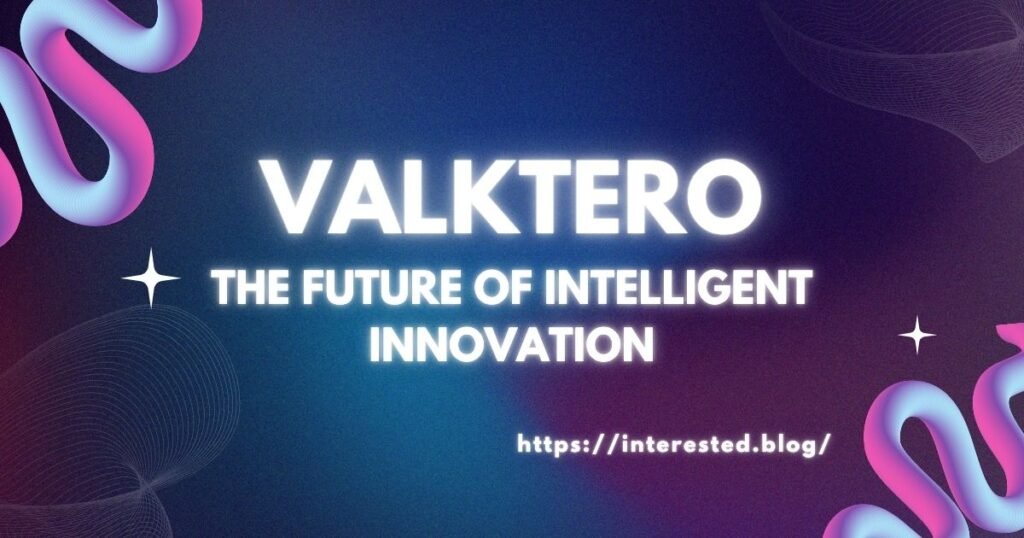Introduction
What if the most repetitive parts of work could vanish, while the most creative parts got a serious upgrade? That’s the promise fueling Valktero. In just a few short years, Valktero has gone from an intriguing idea to a full-blown movement—one that blends automation, AI, and data orchestration into an intelligent layer that sits across your existing tools.
Why is Valktero capturing global attention? Because it doesn’t just automate tasks; it learns, adapts, and orchestrates end-to-end outcomes. Instead of stitching together point solutions, Valktero creates a coherent, self-optimizing fabric across apps, teams, and data.
- Smarter than scripts: Valktero pairs AI with rules to make decisions, not just follow instructions.
- Faster than manual workflows: It compresses hours into minutes by removing swivel-chair steps.
- Continuously improving: Feedback loops help it refine predictions and processes over time.
In the broader digital and business ecosystem, Valktero acts like your “innovation OS”—a control plane for workflows, data, and AI that’s agile enough for startups and strong enough for enterprises. The result? Less drag, more lift.
The Meaning and Origin of Valktero
At its core, Valktero can be understood as a portmanteau combining the spirit of “valkyrie”—the chooser of the worthy—with “hetero” (as in heterogeneous systems) or “vector” (as in direction and magnitude). The name suggests intelligent selection and movement toward optimal outcomes across diverse tools and data.
From concept to creation:
- Problem: Organizations struggled with fragmented stacks, brittle integrations, and siloed intelligence.
- Idea: Build an orchestration layer that unifies data, decisions, and automation—guided by AI and reinforced by telemetry.
- Implementation: Start with easy wins (automating recurring workflows) and graduate to AI-driven decisions, predictive triggers, and autonomous exception handling.
Over time, Valktero evolved from a clever integration toolkit into a holistic intelligence fabric: a platform that routes data, interprets signals, and acts with purpose.
Valktero in the Modern Context
Today’s business landscape is fast, messy, and unforgiving. Apps proliferate. Data explodes. Teams juggle more tools than ever. In that churn, Valktero matters because it:
- Bridges the last mile of automation. Most tools stop at integrations; Valktero aligns them with business intent.
- Closes the insight-to-action gap. Data isn’t valuable until it drives timely action. Valktero operationalizes that loop.
- Scales decisions, not just tasks. It embeds intelligence where work happens, so outcomes improve autonomously.
The gap it fills: Traditional automation is great at “if-this-then-that.” Valktero asks, “Is that the right next action given risk, context, and priority?” It blends rules, models, and human-in-the-loop design to get there.
Core Principles Behind Valktero
Valktero isn’t just a stack—it’s a philosophy:
- Innovation by design: Favor composability over complexity. Ship small, learn fast, integrate everywhere.
- Scalability as a default: Stateless services, parallelizable workloads, and event-first architecture.
- Intelligence as a loop: Collect telemetry → analyze → act → learn → repeat.
- Human-centric control: Keep people in the loop where judgment matters; automate the rest.
- Trust and resilience: Secure by default, observable end to end, recoverable under stress.
The Valktero ecosystem emerges from those principles: a mesh of services that flex to your unique stack while preserving guardrails and governance.
Understanding How Valktero Works
Think of Valktero as a traffic controller and co-pilot for your operations:
- Listen — It ingests events (orders placed, tickets escalated, sensors pinging thresholds).
- Understand — It interprets context with rules, embeddings, or ML models.
- Decide — It selects the next best action using policies and predictions.
- Act — It triggers workflows across CRMs, ERPs, support desks, data warehouses, and custom apps.
- Learn — It captures outcomes to refine future decisions.
For non-technical teams: imagine your processes as a set of “plays.” Valktero chooses and runs the best play based on the scoreboard, opponent, and time left—then studies the tape to improve.
Valktero’s Unique Features and Capabilities
What makes Valktero stand out?
- Context-aware orchestration: Actions adapt to customer tier, SLA, geography, and risk signal.
- Unified data plane: Real-time sync and reconciliation across heterogeneous systems.
- Composable automations: Drag-and-drop flows with reusable blocks; code where you want it, no-code where you don’t.
- LLM-assisted agents: Natural-language instructions convert into robust, governed workflows.
- Observability & guardrails: Trace every decision, alert on drift, enforce policies.
Practical applications:
- E-commerce: Prioritize high-value orders, prevent fraud, auto-resolve shipping exceptions.
- Healthcare ops: Route referrals, verify benefits, pre-populate forms, escalate anomalies.
- Customer success: Predict churn risk and trigger proactive outreach with tailored playbooks.
- Finance back office: Auto-match invoices to POs, flag anomalies, post journal entries with approvals.
- Logistics: Optimize pick/pack/ship sequences based on capacity, carrier SLAs, and weather signals.
Valktero in Business Transformation
Enterprises adopt Valk tero not just to “do the same things faster” but to rethink how work flows:
- Operational efficiency: Cycle times drop as handoffs disappear.
- Quality and compliance: Embedded checks lower error rates and audit friction.
- Customer experience: Faster, smarter responses that feel personalized.
Illustrative success snapshots (fictionalized but representative):
- Retailer “NorthStar” reduced order-to-ship time by 38% by unifying OMS, WMS, and carrier systems through Valk tero.
- Fintech “Arbor” cut reconciliation effort by 60% with AI-assisted matching and exceptions routing.
- MedTech “PulseWave” improved claim first-pass rates by 22% by validating data at intake, not after denial.
The Technology Stack Behind Valktero
A typical Valktero deployment embraces cloud-native resilience and AI-readiness:
- Core services: Containerized microservices orchestrated via Kubernetes.
- Event backbone: Kafka or Pulsar for high-throughput streaming; outbox patterns for reliability.
- Data layer: Relational stores for transactions; data lakehouse for analytics; vector DBs for semantic search.
- AI & decisioning: LLMs for text understanding, ML for predictions, rules engines for policy, and retrieval for grounding.
- Integration fabric: API gateway, iPaaS connectors, webhook listeners, and ETL/ELT bridges.
- Security & governance: RBAC/ABAC, secrets management, key rotation, audit trails, and policy-as-code.
- Observability: Distributed tracing, metrics dashboards, log correlation, and anomaly detectors.
Compatibility: Valk tero plays well with modern AI, analytics, and automation tools—embedding insights in the flow of work rather than forcing users to swivel between dashboards.
Comparing Valktero to Other Platforms

How does Valktero differ from legacy automation suites or point AI tools?
- RPA vs. Valktero: RPA mimics clicks; Valk tero orchestrates intent across systems and data.
- iPaaS vs. Valktero: iPaaS connects apps; Valk tero decides what to do with connected context.
- Standalone LLM apps vs. Valktero: LLMs chat; Valk tero acts—grounded by policies, data, and guardrails.
Why it’s more adaptable:
- Modular architecture, policy-driven decisions, and real-time telemetry make Valk tero quick to adjust when business rules or market conditions change.
Benefits of Adopting Valktero
- Improved productivity: Automate the 80% so humans can master the 20% that moves the needle.
- Smarter workflows: Context and predictions guide every action.
- Cost-effectiveness: Less integration sprawl, fewer bespoke scripts, more reuse.
- Future-readiness: AI-first foundation that welcomes new models, data, and tools.
Bonus advantages:
- Shorter onboarding time for new team members (processes are explicit).
- Better compliance posture via traceable, policy-enforced decisions.
- Higher customer satisfaction as cycle times and error rates drop.
Potential Challenges and Limitations of Valktero
No platform is a silver bullet. Typical hurdles include:
- Misconceptions:
- “It’ll replace people.” → Valk tero elevates people to higher-value work.
- “It’s only for big companies.” → Startups can deploy selectively to punch above their weight.
- “It’s just another automation tool.” → It’s an intelligence layer, not a point solution.
- Integration realities: Legacy systems or non-standard APIs may require adapters and patience.
- Scalability pitfalls: Without good event design and idempotency, scaling can hurt—Valk tero encourages patterns that prevent this.
Overcoming issues: Start with a narrow, high-value use case; establish telemetry and guardrails early; incrementally widen scope.
Valktero for Startups and Entrepreneurs
Startups choose Valktero because it provides enterprise-grade leverage without enterprise-grade bureaucracy:
- Rapid prototyping: Build flows in hours, not months.
- Affordable models: Usage-based pricing and modular add-ons keep costs aligned with growth.
- Plug-and-play: Connect to CRMs, help desks, payment gateways, data stores, and analytics tools.
- AI acceleration: Use LLMs for triage, classification, and content generation—safely governed.
Founder tip: Prioritize flows tied to revenue or retention first (lead routing, onboarding, support triage). The ROI is immediate and measurable.
Valktero in AI and Automation
Valktero treats AI as a decision partner, not a bolt-on:
- Retrieval-augmented actions: Ground model outputs in your data to reduce hallucinations.
- Human-in-the-loop: Auto-propose, human-approve for high-impact steps.
- Continuous learning: Feed outcomes back to models to improve over time.
- Agentic workflows: Multi-step agents coordinate tasks with tool use and explicit guardrails.
Shaping automated intelligence: As more processes run through Valk tero, the platform becomes a self-improving control plane, raising the floor for speed and the ceiling for innovation.
Valktero and Sustainability
Digital sustainability is no longer optional. Valk tero helps reduce waste by:
- Eliminating redundant compute: Intelligent routing avoids unnecessary workloads.
- Optimizing data movement: Push compute to data when possible; minimize costly transfers.
- Right-sizing resources: Autoscaling and spot instances reduce idle capacity.
- Reducing rework: Fewer errors = fewer cycles = lower carbon impact.
Eco-conscious innovation means shipping smarter, not just faster.
Security and Data Protection in Valktero
Security isn’t a feature—it’s the foundation. Valk tero emphasizes:
- Encryption in transit & at rest for sensitive data.
- Identity and access management with least-privilege roles and fine-grained permissions.
- Data minimization & retention controls to keep only what you need, as long as you need it.
- Audit trails & policy enforcement to satisfy governance and compliance requirements.
- Environment isolation (dev/stage/prod), secrets management, and regular key rotation.
Privacy frameworks and regional data residency requirements can be modeled as policies so automations adhere to jurisdictional rules by default.
Future Roadmap: What’s Next for Valktero

While specifics vary by deployment, the directional roadmap is clear:
- Deeper agent capabilities: Multi-agent collaboration with shared memory and role-based goals.
- Native copilots: First-class assistants embedded in every user workflow.
- Unified knowledge layer: Enterprise-wide vector indexing with zero-trust access.
- Autonomous optimization: Self-tuning flows based on outcome metrics and cost constraints.
- Community pack library: Open templates for common industry use cases.
Expect a steady march toward more autonomous, explainable, and policy-aware operations.
Real-World Use Cases of Valktero
Let’s make it concrete with outcome-focused examples (illustrative):
- Healthcare: Automate prior authorization checks, populate forms, and escalate anomalies → shorter patient wait times and higher first-pass approvals.
- Education: Route support tickets, sync SIS and LMS data, and generate personalized nudges → better student engagement and fewer back-office bottlenecks.
- Finance: Auto-classify transactions, detect anomalies, and streamline close → faster books with fewer discrepancies.
- Logistics: Predict capacity crunches and re-route dynamically → on-time delivery up, penalties down.
Performance metrics to track:
- Lead response time
- Order-to-cash cycle time
- First-contact resolution rate
- Exception rate per 1,000 events
- Cost per automated outcome
How to Get Started with Valktero
Beginner’s guide:
- Pick a “lighthouse” workflow. Choose one with clear metrics and recurring pain.
- Define success. E.g., “Cut cycle time by 30% in 60 days.”
- Map the systems. Identify sources of truth, APIs, event streams, and stakeholders.
- Design the playbook. Rules, model prompts, human checkpoints, and alerts.
- Ship a v1. Measure, learn, iterate.
- Scale to adjacent flows. Reuse blocks; add telemetry; tighten policies.
Pricing & accessibility: Organizations often start with a limited scope—usage-based or tiered plans make it easy to prove value before expanding.
Tips for early adoption:
- Keep humans visible in the loop (confidence thresholds, approvals).
- Instrument from day one (metrics, traces, drift alerts).
- Create a “patterns” library for reuse across teams.
Expert Opinions on Valktero
Industry voices consistently note that the battle is shifting from tool features to orchestration intelligence. The consensus:
- The winners will be those who operationalize AI, not just analyze it.
- Governance must be built-in, not bolted on.
- Composability beats monoliths, and policy-aware agents will become the norm.
Thought leaders emphasize Valk tero’s sweet spot: connecting insight to action with every step traced and tuned.
Valktero in the Media and Research
Coverage and research commonly highlight:
- Time-to-value: Fast wins in weeks, not quarters.
- Explainability: Decision logs that auditors and execs can understand.
- Platform gravity: As more workflows land, the flywheel accelerates.
Case studies frequently underscore measurable gains in cycle time, satisfaction, and cost per outcome.
How Valktero Shapes the Future of Digital Innovation
Valktero points to a world where systems collaborate instead of collide. Data is not trapped in dashboards; it is activated in workflows. AI doesn’t just answer questions; it initiates the right actions—with context, confidence, and compliance.
Smarter, interconnected ecosystems look like this:
- Data signals → Decisions → Actions → Telemetry → Better decisions.
- Teams shift from triage to strategy.
- Innovation cycles compress as reusable building blocks spread across the org.
In short, Valk tero helps organizations move from being tool-rich and outcome-poor to tool-coordinated and outcome-obsessed.
Final Thoughts
Trends fade; operating systems endure. Valktero is best understood as an operating system for intelligent work—a layer that learns, adapts, and scales with you. It brings order to complexity, turning scattered tools into a cohesive, evolving capability.
If you’re looking for leverage—real, compounding leverage—Valk tero offers a path: start small, connect the dots, add intelligence, and let the flywheel spin. The future belongs to organizations that can decide well, act fast, and learn continuously. That’s Valktero’s lane.
FAQs about Valktero
Q: What industries can benefit most from Valktero?
A: Any industry with complex processes and multiple systems gains leverage—retail, finance, healthcare, logistics, SaaS, education, and manufacturing are all strong fits.
Q: Is Valktero open-source or proprietary?
A: Valktero is typically deployed as a commercial platform with open interfaces: APIs, webhooks, and connectors that encourage extensibility and integration with open-source tools.
Q: How does Valktero differ from traditional automation platforms?
A: Traditional tools automate steps; Valktero automates decisions. It fuses rules, AI, and real-time data to orchestrate outcomes with built-in governance and telemetry.
Q: Does Valktero require data scientists to implement?
A: Not necessarily. Business teams can start with rules and prebuilt models. As needs mature, data scientists can plug in custom models and pipelines.
Q: How quickly can teams see value?
A: Many teams realize measurable wins within the first 30–60 days by targeting a high-impact workflow and iterating fast.
Read More Content: Impactful Representation Pondershort


